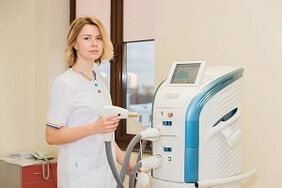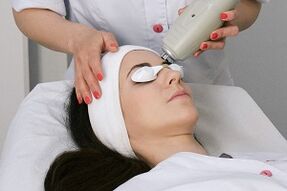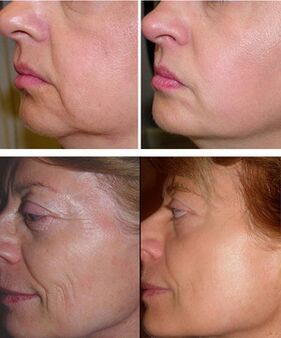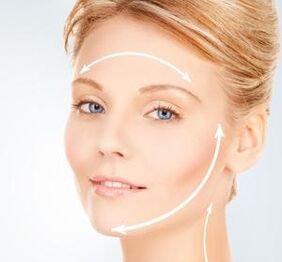
Facial skin is definitely subject to a natural aging process, which modern cosmetics and cosmetic procedures can combat.
One of these procedures is laser facial rejuvenation - thanks to the technique, cell rejuvenation and restoration mechanisms are triggered, facial skin acquiring a youthful, fresh, and well-groomed appearance.
In cosmetology, special lasers are used to get rid of various skin problems. Fractional laser skin rejuvenation is quite popular - a cosmetic procedure, after which you can increase skin elasticity, remove fine and deep wrinkles, and tighten the oval of the face. After completing one course, you will look several years younger.
Core and effect techniques

Laser facial skin rejuvenation is a laser radiation technique that acts on the skin. For this, a laser source is used - a laser installation - equipment that makes it possible to adjust the depth of penetration of the laser light into the skin, the time of exposure and the temperature of the radiation.
The correct choice of parameters of the procedure is the most important condition for successful rejuvenation, because at the slightest mistake of the cosmetologist, burns can appear on the face.
Penetrating into the tissue, the laser beam causes minor damage to cells, in response to the irritation that occurs, cells begin to actively produce collagen and elastin, and new cell growth continues.
The stimulation of the regeneration process leads to the complete renewal of the facial skin, its rejuvenation. The second name for this procedure is laser peeling.
Indications and contraindications
This technique is used to remove age-related changes in facial skin:
- Wrinkles.
- Dark spot.
- Softness and sagging.
Indications also for this procedure are:
- Scars, bumps on the face.
- Acne scars.
- Unwanted tattoos.
- Skin keratinization.
- Enlarged pores.
- Vascular mesh on the face.
- Stretch marks on the abdomen and legs after pregnancy.
Laser peeling contraindications are:
- Keloid scars.
- Malignant neoplasm.
- Pregnancy, breastfeeding.
- Herpes infection during exacerbation.
- Wounds and abrasions on the face.
- Any skin disease.
- Fresh tan.
- Mole.
- Take medication to treat acne.
In most cases, laser rejuvenation occurs without complications, the first few days after the procedure, the patient experiences slight swelling, redness and peeling of the epidermis. This phenomenon is normal for a laser that peels off and goes away on its own after a few days.
Possible side effects

But in some cases, the following side effects can develop:
- Persistent facial redness.
- Acne exacerbations.
- Increased oiliness of the skin.
- The appearance of hyper- or hypopigmentation.
- Herpes eruption (if the patient has previously been diagnosed with herpes).
- Burns.
- Maintain the boundary between treated and untreated skin areas.
- Subcutaneous bleeding.
The listed side effects go away for a long time and require additional care from a cosmetologist.
The advantages and disadvantages of peeling
Fractional skin is widely used because of the following benefits:
- High efficiency, the ability to remove significant aesthetic imperfections.
- Possible on all skin types.
- Minimal risk of side effects (burns and hyperpigmentation).
- Painless.
- Short-term recovery of the skin.
- The ability to treat large areas of skin at once.
The disadvantage of fractional peeling is its high cost compared to other methods, but given the effectiveness of the procedure, this disadvantage can be considered insignificant.
Laser rejuvenation type
There are several types of laser rejuvenation, depending on the depth of laser penetration:

- Laser resurfacing. . . The laser "works" on the surface layer of the epidermis, sloughing off dead cells. The results of the procedure become visible after a week: the skin becomes velvety to the touch, fine wrinkles disappear. During the procedure, three types of laser light are used: erbium, carbon or neodymium.
- Laser biorevitalization. . . The radiation penetrates into the deep layers of the skin, while some cells are damaged. This technique is tougher than laser resurfacing, but provides a strong anti-aging effect. To enhance the laser effect, beauticians apply a nutrient mixture to the skin. After the procedure, deep wrinkles disappeared and facial contours improved. Recovery after biorevitalization occurs within three months, edema and severe peeling of the epidermis may persist on the face during this period.
- Exfoliation. . . Fractional laser rejuvenation is the most effective and gentle method at the same time. The peculiarity of this procedure lies in the fact that the laser beam is broken down into many micro-rays, which cause a gentle effect on the skin. The radiation hits the skin in the form of a net, therefore, the intact area remains between the focus of cell damage - this contributes to faster tissue regeneration and a stronger rejuvenating effect. The strength of the light during fractional exfoliation can be changed using carbon dioxide or an erbium laser.
Procedure stages
Before carrying out this procedure, you must make an appointment with a cosmetologist. The doctor identifies the problem at hand, asks the patient if there are contraindications to the procedure, talks about how laser rejuvenation will be carried out.
If the patient's skin is prone to increased pigmentation, a whitening cream will be prescribed several days before the rejuvenation session. Patients should know that prior to the procedure, one should not exercise, do strenuous physical labor, or drink alcoholic beverages.
Order of fractional exfoliation:
- The face is cleaned using conventional cosmetics.
- Anesthetic cream applied to the skin.
- After several minutes, the anesthetic is washed off, the gel is applied to facilitate shifting of the nozzle of the fractional apparatus. Glasses are placed over the patient's eyes.
- The doctor moves the nozzle over the face, affecting each area sequentially with a laser.
- The treatment lasts 15-60 minutes, after which a soothing cream is applied to the skin.
In total, you will have to go through 3 - 4 procedures, the interval between them is 1 - 2 months.
Home skin care

After laser treatment, swelling, redness, peeling and itching appear on the skin, and then a crust forms. Patients should follow these recommendations:
- Apply a cold compress to your face to reduce puffiness.
- Apply an anti-inflammatory and soothing cream to the skin (prescribed by a beautician).
- Use sunscreen on your face before going outside.
- Do not go to a bath, sauna, or hot bath for two weeks after the procedure.
- Don't use scrubs; apply cosmetics only after permission from a cosmetologist.
- Do not remove the scale that forms to prevent scars from appearing on your face.
If the laser rejuvenation is carried out by a highly qualified specialist, and the patient follows all the recommendations of the doctor, the result of the procedure is pleasant with a wonderful cosmetic effect.














































































